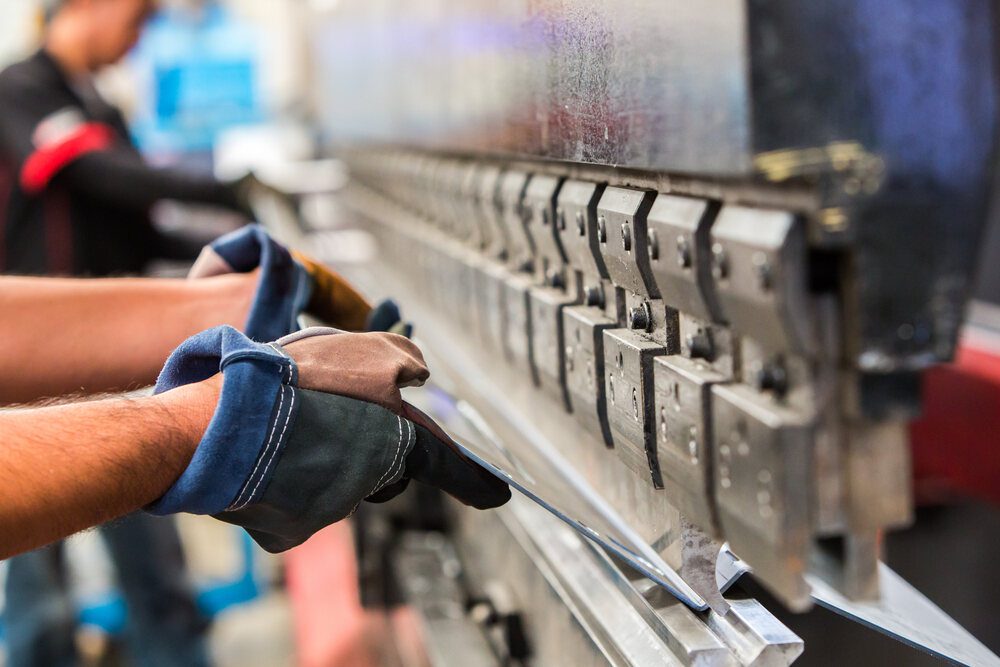
What is sheet metal bending?
The sheet metal bending process involves a flat metal sheet (usually made of steel, aluminum, or stainless steel), a punch, and a die. The punch applies force to the metal sheet, deforming and bending it into the desired shape. Meanwhile, the die provides support and controls the angle and radius of the bend.
The bending process uses various methods and equipment, including press brakes, folding machines, and roll bending machines. Press brakes, for example, are widely used in industrial settings and can exert high forces to bend thick and large sheets. On the other hand, folding machines are suitable for precise and repetitive bending operations.
Sheet metal bending plays a crucial role in the manufacturing process. It allows manufacturers to transform flat metal sheets into complex shapes and components vital for constructing various products. From simple brackets and enclosures to intricate automobile parts and aircraft structures, sheet metal bending enables the creation of objects that meet specific design requirements.
What is sheet metal bend allowance?
Sheet metal bend allowance is a critical element of sheet metal bending that compensates for material stretch and spring back during bending. The bend allowance involves adding a calculated dimensional compensation to the flat length of a sheet metal component to ensure that the final part is bent to the specified dimensions.
During bending, sheet metal undergoes deformation and elongation as the outer surface stretches and the inner surface compresses. As the bending force releases, the metal tends to spring back slightly toward its original shape. Bend allowance is calculated based on factors like material properties, thickness, bend radius, and the angle of the desired bend to account for these changes.
Manufacturers utilize specialized software or reference tables to calculate the exact bend allowance based on specific parameters. This compensation ensures that the bent parts meet the specified dimensional requirements, preventing issues such as components falling short or exceeding the intended dimensions.
By calculating the potential material stretch and spring back in the bending process, metalworkers can consistently produce high-quality parts with accurate dimensions. Sheet metal bend allowance is critical to maintaining dimensional integrity and ensuring proper fit and assembly of the final products.
What are the different sheet metal bending techniques?
With various sheet metal bending techniques available, each method offers unique advantages and limitations, making it crucial to understand the differences for successful sheet metal fabrication. Learn more about each method below.
1. Air Bending
Air bending involves deforming a metal sheet by applying force without fully bottoming out the punch into the die. During the air bending process, the punch pushes the sheet metal into the die cavity, but it does not come into contact with the bottom of the die. This gap between the punch and the die allows more flexibility and control over the bending angle.
Air bending is versatile, as metalworkers can use it to achieve a wide range of bending angles with a single set of tools. It also minimizes tooling costs since only a single V-shaped die is required. Additionally, air bending reduces the risk of damaging the sheet metal by avoiding direct contact between the punch and the die. However, air bending requires careful calculation of the bend allowance to ensure accurate dimensions and has limitations regarding achievable bend angles.
2. Bottom Bending
Bottom bending, also known as die bending or edge bending, is a technique where the metal sheet is pressed against a die to bend it around a bend line. The punch descends fully into the die, making contact with the bottom, and applies force to deform the sheet metal into the desired shape.
Bottom bending enables manufacturers to achieve precise and consistent bend angles. This technique is suitable for bending thicker and heavier sheets, as the bottoming action ensures a more uniform deformation. However, bottom bending requires specific tooling for each bend angle and may result in elevated costs.
3. Coining
Coining is a sheet metal bending method that involves applying high pressure to compress and deform the metal sheet between a punch and die. The process produces precise and sharp bends with no spring back. Coining is often used to create intricate and highly accurate parts with tight tolerances.
Coining applications include producing precision components in the electronics, aerospace, and medical device industries. It provides excellent dimensional control, resulting in parts with high accuracy and repeatability.
4. Roll Bending
Roll bending is a technique typically for handling curved or cylindrical shapes in sheet metal. It involves passing the metal sheet through a series of rolls to gradually bend it into the desired shape. There are different types of roll-bending machines, including three-roll, four-roll, and pyramid configurations.
The advantages of roll bending include the ability to produce long and continuous bends in sheet metal. It allows for a variety of bending radii and can create complex shapes.
Roll bending requires careful adjustment and alignment of the rolls to ensure uniform bending and prevent material distortion. It is essential to consider factors such as material thickness, mechanical properties, and the desired radius of curvature for successful roll bending.
5. Press Brake Bending
Press brake bending is a widely used sheet metal bending technique that uses a press brake machine to bend the metal sheet. The device consists of a punch, which descends into a V-shaped die, applying force to deform the sheet metal. Press brakes are available in mechanical, hydraulic, and electric types, and each one offers different advantages and capabilities.
Press brake bending is versatile and suitable for an array of applications, from simple bends to complex geometries. It provides precise control over bend angles and offers high repeatability. Common applications of press brake bending include the production of brackets, enclosures, and automotive components.
6. Rotary Bending
Rotary bending, also known as roll forming, is a method that involves bending sheet metal by passing it through a series of rollers with gradually changing contours. The rollers deform the metal and slowly shape it into the desired curved or angular form.
The advantages of rotary bending include creating continuous, long bends with consistent and precise dimensions. Rotary bending is suitable for producing profiles and shapes with complex cross-sections. However, rotary bending requires specialized equipment and tooling.
Rotary bending is unsuitable for tight radius bends or materials with limited ductility. Best practices for rotary bending involve carefully selecting the appropriate roller contours and controlling the material feed to achieve the desired shape accurately.
7. Hot Metal Bending
Hot metal bending is a process that involves heating the metal sheet to an elevated temperature before bending it. Heating the metal reduces its yield strength and allows for easier plastic deformation during bending. The heated sheet is then shaped using various bending techniques, such as press brake bending or bottom bending.
Hot metal bending offers several benefits, including increased formability, reduced spring back, and improved bendability for materials with higher tensile strength. It is commonly used for bending high-strength alloys and materials with limited ductility.
Considerations for hot metal bending include temperature control, material selection, and handling safety measures due to the elevated temperatures involved.
6 Tips for Successful Sheet Metal Bending
Achieving accurate and consistent sheet metal bends requires careful consideration of various factors. These tips play a crucial role in ensuring successful sheet metal bending results, whether it’s a simple bend or a complex fabrication project.
1. Material Selection
Choose the appropriate type and thickness of sheet metal for your specific bending project. Consider the ductility, strength, and formability of the metal to ensure successful bending results.
2. Tool Selection
Selecting the right tools for the bending method and the thickness of the sheet metal is essential to any sheet metal bending task. With your sheet metal bending tools, be sure to consider factors such as the bending angle, bend radius, and previous requirements when choosing the tool to ensure accurate and consistent bends.
3. Proper Setup
Ensure that the bending tool and the sheet metal are correctly aligned and securely clamped before beginning. Properly ensuring that the sheet metal is secure will help prevent slippage, deformation, or misalignment during the bending process, resulting in bends that accurately reflect the specified dimensions.
4. Bend Allowance Calculation
Always calculate the bend allowance or the amount of material that stretches on the inside of the bend, and adjust the sheet metal’s dimensions accordingly. Calculating the bend allowance helps achieve accurate bend angles and avoid distortion or defects in the final product or part.
5. Bending Sequence
Always plan the bending sequence carefully before beginning complex projects that require multiple bends. Consider the sequence of bends, the order of operations, and any necessary intermediate steps to achieve the desired shape without damaging the sheet metal.
6. Tool Maintenance
Ensure your sheet metal bending tools are clean, sharp, and properly calibrated to maintain accurate and consistent bending results across different projects. Regular maintenance and inspection of tools help prevent wear and tear, reduce downtime, and ensure optimal performance.
Precision Machine Fabrication’s Sheet Metal Bending Service
Ready to take your sheet metal bending projects to the next level? Trust Precision Machine Fabrication’s expertise in sheet metal bending. Contact us now to discuss your specific requirements and get a quote. Our skilled team and state-of-the-art equipment are ready to deliver precise, high-quality bends for your sheet metal parts.
Request a quote today and experience the precision of our sheet metal bending service!


View Our Work
